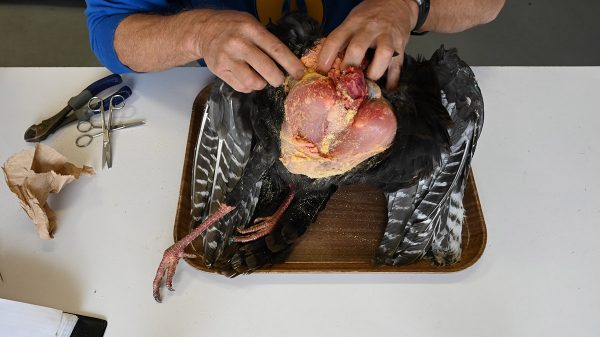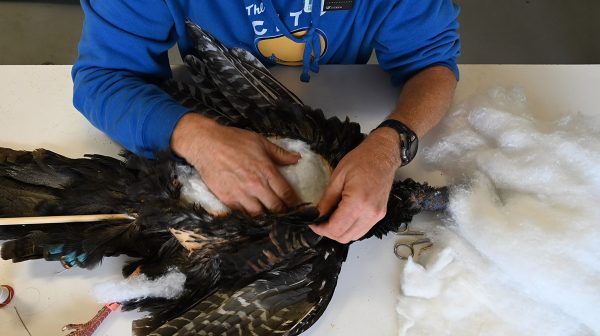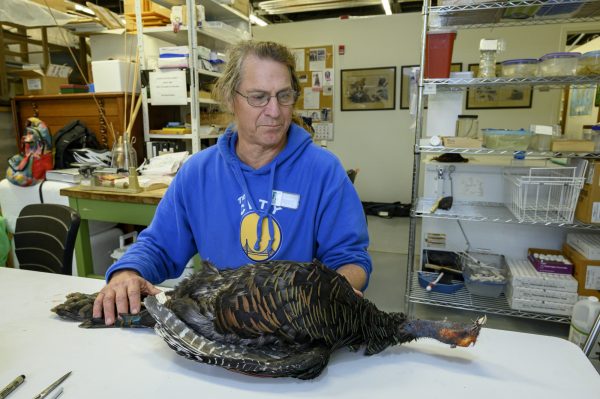The Florida Museum of Natural History added its own stuffed turkey to the estimated 45 million birds about to be gobbled up across the U.S. this holiday – but you wouldn’t want to bite into this one.
Plumped with cotton, this turkey is meant to last for generations as a specimen in the museum’s ornithology collection, which holds more than 53,000 bird skeletons and skins, 11,000 nests and eggs, and 27,500 audio recordings available for study to University of Florida students and scientists around the world.
Longevity isn’t the only thing that sets this bird apart. It’s an ocellated turkey, Meleagris ocellata, a species native to Mexico, Guatemala and Belize. After dying of natural causes, a pair of ocellated turkeys was donated to the museum for scientific study by the Sylvan Heights Bird Park in North Carolina. These turkeys feature a blue, warty head and plumage with flashy bands of iridescent green, bronze and cornflower blue overlaying boldly striped wings and dark tail feathers stippled with white.
Entrusted with stuffing a female ocellated turkey was Andrew Kratter, a Florida Museum ornithology collection manager and bird preparator extraordinaire who has prepped nearly 200 specimens this year. In the chair beside him, David Steadman, ornithology curator, prepared a male ocellated turkey skeleton.
As feathers flew, Steadman explained why he and Kratter make a good team: “I can make a skeleton quickly, and Andy is a much better skinner of birds. Making a good skin is much more of an art than making a good skeleton.”
If you’d like to follow Kratter’s turkey stuffing recipe, you’ll need a few hours, steady hands and a lot of cornmeal. And fair warning: We prefer our birds on the dry side.
How to stuff a turkey, museum-style
Defrost your turkey.
Measure and record the length of its wings, bill, tail and legs. If you have a wild turkey, take notes on the wear of the feathers and any molting in the tail and wings. Weigh the bird.
Label three tubes for tissue samples and set aside.
With a small pair of scissors, cut down the middle of the turkey’s breast, a place where no feathers are attached. Make an incision in the back of the neck and wings.
Sprinkle a generous amount of cornmeal over the insides. Cornmeal helps absorb fat and blood and keeps the plumage clean. It also gives you traction as you handle the specimen. Birds can be greasy.

Florida Museum photo by Ferna Simbulan
Remove the muscles. If you’re preparing a whole or partial skeleton as well as a skin, carefully take the bones apart at the joints. Don’t break them.
Now you are ready to collect the tissue samples. Take a snippet from the heart, liver and muscle and place inside your labeled tubes. Immediately put the tubes in a freezer – organic material starts to break down quickly. These tissue samples preserve the bird’s genetics for future molecular work.
Check the bird’s gonads. This is important, even in species in which males and females have strikingly different colors or patterns. Occasionally, a bird will feature the plumage of one sex and the reproductive organs of the other.
Set the bones and muscle aside. You won’t be eating any meat from this particular turkey. The unsaved parts are considered biohazards because of diseases that birds may carry, so they must be incinerated. If you’re keeping the skeleton, you can place the bones in a container with dermestid beetles. These flesh-eating insects will eat any remaining muscle and leave the bones shiny and clean. Afterward, rinse the bones and label each one so they can be used for future study. The more parts of a specimen you keep, the more valuable it is to science.
Return to the skin. Remove all the fat by gently pulling or scraping it away. You can use scissors for very fatty parts, but cut delicately to avoid creating any holes in the skin. If you leave the fat intact, it will gradually liquify and seep onto the skin and feathers of your specimen – you don’t want that.
Take the turkey skin outside and shake off any remaining cornmeal to avoid attracting bugs (“or French chefs,” Kratter added).
Tie the wings together.
Now your bird is ready to be stuffed.

Florida Museum photo by Ferna Simbulan
Push thumbfuls of cotton into the top of the head. Insert a long wooden rod in the neck and head and run it along the back of the turkey and out the bottom. The rod acts as a backbone, giving the specimen structural strength so it won’t flop around when handled.
Stuff the inside of the turkey with handfuls of cotton until full. Lay the turkey on its back and sew up the incision along the breast. Cross and tie the legs and anchor them and the wings to the wooden rod.
Ruffle, then preen and smooth the feathers so they all lie the same way.
On a label, write the bird’s scientific name, the University of Florida catalog number, the preparator’s catalog number, and where and when the bird was collected. All of this information is important for other scientists who study this specimen.
Your turkey is ready to dry. Wrap it loosely in cotton so it keeps its shape and put it in a screened cabinet. Wait 10 to 14 days or until the turkey is completely dry. After fumigation guarantees it is bug-free, you can add your specimen to the collection.

Florida Museum photo by Kristen Grace
Sources: David Steadman, dws@flmnh.ufl.edu;
Andrew Kratter, kratter@flmnh.ufl.edu, 352-273-1973